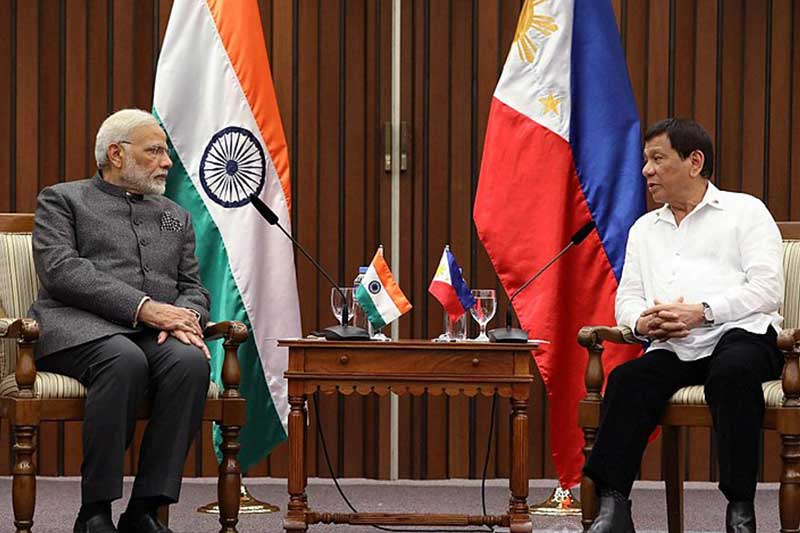India and Philippines: Decades of ties, different ways of dealing with China

President Rodrigo Duterte held a bilateral meeting with India Prime Minister Narendra Modi at the sidelines of the ASEAN-India Commemorative Summit in New Delhi this week. Presidential Photo/Karl Norman Alonzo
MANILA, Philippines — Philippine President Rodrigo Duterte on Wednesday flew to India, a sub-continent that, according to some analysts, is courting Southeast Asian leaders to counter rival China’s influence over the region.
According to Malacañang, the 10 leaders of the Association of Southeast Asian Nations will attend a retreat session with Indian Prime Minister Narendra Modi that is expected to focus on maritime cooperation and security.
India and the Philippines formally established diplomatic relations in 1949, and one of the things that the two nations have in common is their territorial spat with Beijing, which is known for its assertive military posture in the region.
However, their ways of dealing with China’s aggression differ.
Ties between Manila and Beijing had soured after the Philippines filed a case, and won, in a United Nations-backed tribunal against China’s sweeping claims over South China Sea.
The international court said in 2016 that China violated the Philippines’ sovereign rights by blocking fishing and oil exploration as well as by building reclaimed islands there.
India, at the time the Philippines was pursuing the arbitration case against China’s maritime encroachment, asserted the importance of safeguarding freedom of navigation and overflight in the disputed waters.
But upon winning the 2016 presidential elections, Duterte set aside the tribunal’s verdict in exchange for warmer ties and billion dollars’ worth of Chinese investments.
“As far as the issue of South China Sea is concerned, we have always maintained that freedom of navigation is an important element,” Indian Foreign Ministry Secretary (East) Preeti Saran said in a media briefing ahead of the ASEAN-India Commemorative Summit.
“Threat or use of force is not acceptable and that any navigation through global commons should be in keeping with rule based system,” she added.
China is also in dispute with India over territory along their Himalayan border.
The two nuclear powers went to war over it in 1962 and nearly came to blows in 2017.
Officials from both sides reportedly agreed to give some ground in order to end the standoff.
READ: India, China hold talks on long-running border dispute
“India's ASEAN commitment reflects an ambition to create a bulwark against the emergence of a Sino-centric regional order,” political analyst Chietigj Bajpaee said in a commentary published on Lowy Institute, a Sydney-based think tank.
“While the agenda for the India–ASEAN Commemorative Summit will be dominated by discussions on counterterrorism, connectivity and culture, China will undoubtedly be the elephant (or dragon) in the room,” he added.
There are about 3,000 Filipinos in India, 400 of them living in the Indian capital of New Delhi.
India and the Philippines signed a Trade Agreement in 1979. Data from the embassy show that the two nations’ trade was at around $1.981 billion in 2016-2017.
According to the Embassy, India has a “strong presence” in the Philippine generics sector, with pharmaceutical majors such as Dabur Pharma, Lupin, Torrent, Zydus Cadilla, Claris Life Sciences setting up liaison offices to promote their products.
During Duterte’s visit in the sub-continent, the Philippines has fetched at least $1.25 billion in investment pledges from Indian firms that are expected to create 105,000 jobs.
The Philippine delegation also invited Indian pharmaceutical firms to start manufacturing in the Philippines to ensure the availability of cheap medicines.
- Latest
- Trending
































